Up to 18% of births can result in postpartum hemorrhage, which is defined as the loss of more than 500 mL of blood after delivery.

Postpartum haemorrhage, defined as the loss of more than 500 mL of blood after delivery, can occur in up to 18% of births. More than 1,000 mL of physiologically significant blood loss can cause hemodynamic instability. Even with proper care, a serious postpartum haemorrhage will occur in about 3% of vaginal deliveries.
It is the leading cause of death worldwide and the leading cause of maternal morbidity in developed economies. Postpartum bleeding can cause orthostatic hypotension, anaemia, and exhaustion, which can make it difficult for mothers to care for their newborns.
Postpartum anaemia raises the likelihood of postpartum depression. Hemorrhagic shock can cause anterior pituitary ischemia with delayed or unsuccessful lactation (i.e., postpartum pituitary necrosis), occult cardiac ischemia, dilutional coagulopathy, and death in the most severe cases. Blood transfusion may be required, which comes with its own set of risks.
Bleeding may occur after 24 hours as a result of retained placental fragments or as a result of delayed postpartum haemorrhage, which occurs when the placental eschar sloughs off.
Postpartum haemorrhage is risked by a prolonged third stage of labour, multiple deliveries, episiotomies, foetal macrosomia, and a previous postpartum haemorrhage. It can occur in women who have no risk factors, so doctors must be prepared to treat it at every delivery.
Anemia should be identified and treated prior to delivery, the mother’s views on blood transfusions should be considered, and routine episiotomies should be discontinued.
Check the patient’s vital signs and vaginal flow again before leaving the delivery room to see if there is any slow, persistent bleeding.
The best preventative strategy is the number of cases of postpartum haemorrhage that can be avoided by actively managing the third stage of labour (NNT = 12). Hospital policies that encourage this practise have reduced the occurrence of severe haemorrhage significantly.
Active management reduces the risk of postpartum haemorrhage and shortens the third stage of labour without increasing the risk of retained placenta noticeably. This entails administering a uterotonic medication concurrently with or shortly after anterior shoulder delivery, controlled cord traction, and, in most cases, early cord clamping and cutting.
When compared to expectant management, which relies solely on gravity or nipple stimulation to help the placenta separate spontaneously, active treatment reduces the incidence of postpartum haemorrhage by 68 percent.
